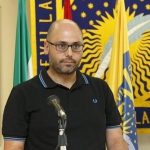
Open Science and Open Data Training Sessions
19apr(apr 19)10:0026(apr 26)11:00Open Science and Open Data Training Sessions
Event Details
The promotion of open science is one of the priorities of STARS EU and is part of Work Package 8 of the funded project. For this reason, this online training
Event Details
The promotion of open science is one of the priorities of STARS EU and is part of Work Package 8 of the funded project. For this reason, this online training programme, divided into four sessions of two hours each, has been created, open to administrative staff involved in open science/open data, researchers, and academic staff.
Dates: April 19, 22, 24 and 26.
Hour: 10:00 CET
Speakers: Eloy Rodrigues, University of Minho (Portugal); Angel Delgado, University Pablo de Olavide (Spain)
Information to follow the training: The sessions can be followed using this Google Meet link. ey can use the video link. Alternatively, if the capacity of the room (250 people) is reached, or there is not interest in asking any questions, it can be followed via streaming.
Porgramme
- Session 1 (120 minutes): April, 19th
Speaker: Eloy Rodrigues- I – Introduction: The concept, definitions, components, and dimensions of open science.
- II – Open Access to Publications – What, why, and how. The colors and flavors of open-access.
- Session II (120 minutes): April, 22nd
Speaker: Ángel Delgado- I – Research data management in the context of Open Science.
- II – Fundamentals of Research Data Management in the Context of Open Science. FAIR data. Legal and ethical aspects in the processing of research data. Store your data and ensure its security.
- III – Plan the Management of your research data. Creation of research data management plans.Data management during project execution. Working with your data.
- Session III (120 minutes) April, 24th
Speaker: Eloy Rodrigues- I – New models of scholarly publication and communication (preprints, PRC – Publish-Review-Curate – model, open peer review, etc.).
- II – Open Science and research assessment – The Agreement on Reforming Research Assessment and the Coalition for Advancing Research Assessment (CoARA)
- Session IV (60 minutes) April, 26th
Speaker: Ángel Delgado, University Pablo de Olavide, SPAIN- Practical session for librarians: create and manage an open data repository
More information about the speakers:
 Eloy Rodrigues is the Director of the University of Minho Libraries. Eloy has been working on repositories, Open Access and Open Science for almost two decades, having established University of Minho institutional repository in 2003, and coordinating the UMinho team which works on RCAAP (Portugal Open Access Science Repositories) since 2008.At international level he has being working on several EU funded projects (like OpenAIRE and FOSTER) related with Open Access and Open Science and is member of the European University Association Expert Group on Open Science. Eloy was the Chair of the Executive Board of COAR, the Confederation of Open Access Repositories from 2015 to 2021, and in that role contributed actively to Next Generation Repositories initiative, the Pubfair conceptual model and the ongoing Notify Project, in which he is one of the Principal Investigators.
Eloy Rodrigues is the Director of the University of Minho Libraries. Eloy has been working on repositories, Open Access and Open Science for almost two decades, having established University of Minho institutional repository in 2003, and coordinating the UMinho team which works on RCAAP (Portugal Open Access Science Repositories) since 2008.At international level he has being working on several EU funded projects (like OpenAIRE and FOSTER) related with Open Access and Open Science and is member of the European University Association Expert Group on Open Science. Eloy was the Chair of the Executive Board of COAR, the Confederation of Open Access Repositories from 2015 to 2021, and in that role contributed actively to Next Generation Repositories initiative, the Pubfair conceptual model and the ongoing Notify Project, in which he is one of the Principal Investigators.
Eloy is currently member of the Executive Board of OpenAIRE and of the Advisory Committee ofSciELO Portugal.
 Ángel Delgado He holds a degree in Humanities from the Universidad Pablo de Olavide and a degree in Documentation from the Universitat Oberta de Catalunya. He holds a Master’s degree in Libraries and Digital Information Services from the Universidad Carlos III. He works as Head of Learning and Research Support Services at the Library/CRAI of the Universidad Pablo de Olavide.He trains and provides support on issues related to digital research methods, open science, and scientific evaluation and publication, both to researchers, researchers and publishers of academic publications. He provides advice on scientific evaluation tasks to evaluators and decision makers. He has given numerous courses on these subjects to researchers and professionals of research support services in various institutions. He is an assistant professor in the Library and Information Science Department at the Universidad Pablo de Olavide, in Seville, where he is also Coordinator of the Official Master’s Degree in Digital History and Humanities.
Ángel Delgado He holds a degree in Humanities from the Universidad Pablo de Olavide and a degree in Documentation from the Universitat Oberta de Catalunya. He holds a Master’s degree in Libraries and Digital Information Services from the Universidad Carlos III. He works as Head of Learning and Research Support Services at the Library/CRAI of the Universidad Pablo de Olavide.He trains and provides support on issues related to digital research methods, open science, and scientific evaluation and publication, both to researchers, researchers and publishers of academic publications. He provides advice on scientific evaluation tasks to evaluators and decision makers. He has given numerous courses on these subjects to researchers and professionals of research support services in various institutions. He is an assistant professor in the Library and Information Science Department at the Universidad Pablo de Olavide, in Seville, where he is also Coordinator of the Official Master’s Degree in Digital History and Humanities.
He also directs the University Expert Degree in Research Support Services: information, data, evaluation and scientific publication.
more
Time
19 (Friday) 10:00 - 26 (Friday) 11:00